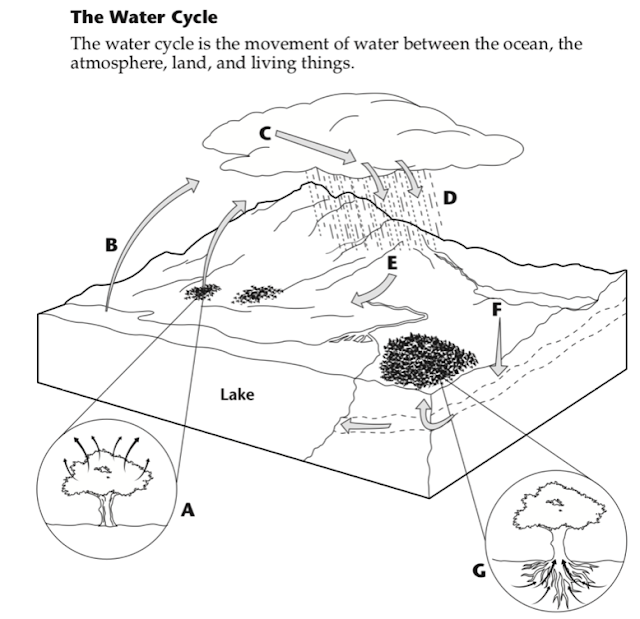Where are we going with this? The information on this page should increase understanding related to this standard: Understand the environment and how each organism fits in and analyze the biogeochemical cycles.
Article includes ideas, images, and content from Troy Smigielski (2022-03)
(Life is a merry-go-round?)
The Law of Conservation insist that matter can neither be created nor destroyed; rather, it only changes forms. So, where does the rain come from? If plants, in a remote jungle without human interaction, use up the nitrogen in the soil, how does more get there?
Nature handles this! There are several cycles of matter within nature!
The Water Cycle
"The water cycle shows the continuous movement of water within the Earth and atmosphere. It is a complex system that includes many different processes. Liquid water evaporates into water vapor, condenses to form clouds, and precipitates back to earth in the form of rain and snow" (Source, 2022-03).
 |
| Source, 2022-03 |
- Water leaves the tree through transpiration.
- Water leaves bodies of water or the ground through evaporation.
- Water condenses within the cloud through condensation.
- Water comes down to earth through precipitation.
- Water moves down by force of gravity; this movement is called runoff.
- Water leaks into the ground through seepage.
- Water is taken back up by plants through root uptake.
Runoff into the ocean produces nutrient-rich coastal waters.
This causes coastal waters to be more productive in terms of energy.
The Carbon Cycle
"The carbon cycle is nature's way of reusing carbon atoms, which travel from the atmosphere into organisms in the Earth and then back into the atmosphere over and over again. Most carbon is stored in rocks and sediments, while the rest is stored in the ocean, atmosphere, and living organisms.
On Earth, most carbon is stored in rocks and sediments, while the rest is located in the ocean, atmosphere, and in living organisms. These are the reservoirs, or sinks, through which carbon cycles.
Carbon is released back into the atmosphere when organisms die, volcanoes erupt, fires blaze, fossil fuels are burned, and through a variety of other mechanisms" (Source, 2022-03).
 |
| Source 2022-03 |
CO2 is found as gas in the atmosphere. How does it get there?
CO2 is also found dissolved in the ocean. This is because water dissolves CO2.
Last, carbon is found as coal, petroleum, and calcium carbonate rock in the ground.
Look at the image above and answer these questions:
What contributes to CO2 in the ocean?What are three activities that put CO2 into the atmosphere?What are the two activities that take CO2 out of the atmosphere?
The Nitrogen Cycle
The nitrogen cycle is a repeating cycle of processes during which nitrogen moves through both living and nonliving things: the atmosphere, soil, water, plants, animals and bacteria. Microscopic living organisms that usually contain only one cell and are found everywhere. Bacteria can cause decomposition or breaking down, of organic material in soils.. In order to move through the different parts of the cycle, nitrogen must change forms. In the atmosphere, nitrogen exists as a gas (N2), but in the soils it exists as nitrogen oxide, NO, and nitrogen dioxide, NO2, and when used as a fertilizer, can be found in other forms, such as ammonia, NH3, which can be processed even further into a different fertilizer, ammonium nitrate, or NH4NO3.
The nitrogen cycle describes how nitrogen moves between plants, animals, bacteria, the atmosphere, and soil in the ground.
For nitrogen to be used by different life forms, it must be changed into different states.
The nitrogen found in the atmosphere is N2.
Other forms of nitrogen used are:
- Nitrates (NO3)
- Nitrites (NO2)
- Ammonium (NH4)
There are 4 important processes that occur during the nitrogen cycle:
1. Nitrogen fixation is when bacteria change nitrogen into ammonium.2. Ammonification is when decomposers turn the nitrogen from a dead plant or animal back into ammonium so it can re-enter the nitrogen cycle.3. Nitrification is when ammonium in the soil is converted to a state that plants can use. This is done by nitrifying bacteria.4. Denitrification is when extra nitrogen in the soil gets put back into the air. This is done by denitrifying bacteria.
One way nitrogen can be aided in entering a plant is through lightning storms.
 |
| Source, 2022-03 |
The Phosphorus Cycle
"The Phosphorus Cycle is the biogeochemical cycle that describes the transformation and translocation of phosphorus in soil, water, and living and dead organic material" (Source, 2022-03).
Phosphorus is mostly contained in rocks and minerals. Phosphorus is an essential nutrient for life as it makes up parts of DNA.
In the phosphorus cycle, phosphorus moves between the soil and plants. The animals use phosphorus, and then their waste products help return it to the soil.
Some of the phosphorus in soil can be washed away into water basins. Another source of phosphorus in water comes from man-made pollution.
Too much phosphorus in water can lead to plant overgrowth which essentially strangles all other life forms in the water.
Bottom Line:
Phosphorus is trapped in rocks and released when rain (which can be acidic) erodes the rocks.









No comments:
Post a Comment